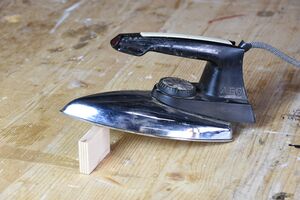Flatiron: Difference between revisions
From CoMakingSpace Wiki
m German name |
furniture repairs |
||
| Line 19: | Line 19: | ||
Common "Maker" uses include applying [[Edge Banding|edge banding]] or ironing [[wax]] into [[fabric]], but feel free to get more creative (and show us your ideas!) as long as it's safe. | Common "Maker" uses include applying [[Edge Banding|edge banding]] or ironing [[wax]] into [[fabric]], but feel free to get more creative (and show us your ideas!) as long as it's safe. | ||
== Furniture Repairs == | |||
[[Veneers]] that were applied with heat-sensitive glue can be removed and re-applied with careful help of a flatiron. | |||
With a few drops of water and the iron set to •• (wool, < 150°C) you may be able to let a dent ''(Delle)'' swell up again and let the damage disappear! | |||
[[Category:Heat]] | [[Category:Heat]] | ||
Revision as of 12:52, 14 July 2022
| MachineInfoBox Flatiron | |
|---|---|

| |
| Synonyms: | iron; DE: Bügeleisen |
| Material: | usually fabric; edge banding |
| Used with: | baking paper |
| Access Requirements: | Read the Wiki Page |
| Tutors: | |
An old flatiron can be very handy in a workshop, e.g. for "dirty work" that you would not risk your nice household iron with.
That does not mean this iron should become filthy, though - for nearly every application, it is best to put a piece of baking paper between the iron and your workpiece.
Common "Maker" uses include applying edge banding or ironing wax into fabric, but feel free to get more creative (and show us your ideas!) as long as it's safe.
Furniture Repairs
Veneers that were applied with heat-sensitive glue can be removed and re-applied with careful help of a flatiron.
With a few drops of water and the iron set to •• (wool, < 150°C) you may be able to let a dent (Delle) swell up again and let the damage disappear!